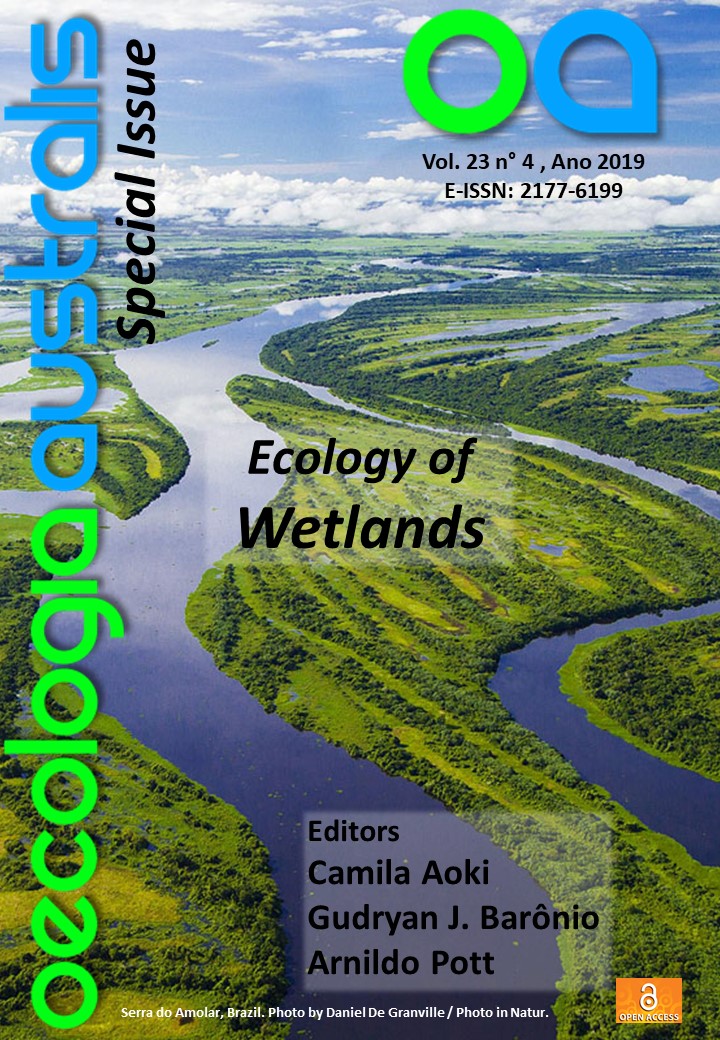USE OF UNDERSTORY FOR FRUGIVORY BY Thrichomys fosteri (RODENTIA, ECHIMYIDAE)
DOI:
https://doi.org/10.4257/oeco.2019.2304.30Palavras-chave:
Pantanal wetland, punaré, Randia armata, understory camera traps, woodland savannahResumo
Thrichomys fosteri (Rodentia, Echimyidae) is a terrestrial spiny rat displaying frugivorous/herbivorous diet. Then, why eventually this terrestrial species uses the understory? Here, we report two events of use of understory for fruit feeding by the spiny rat. Monthly from October 2015 through July 2016, we sampled three sites in one woodland savannah fragment in the Pantanal ecoregion. Each site was 1 km apart from each other, and present five camera traps on understory (1.5 m height) in front of different fruit plant species. With an effort of 350 camera trap-days, we recorded twice the punaré on branch of Randia armata (Rubiaceae) feeding on its fruits. Our results highlight a feeding behaviour on understory by the terrestrial spiny rat, which contribute to the understanding of the species’ natural history as well as point out questions for further investigations.Referências
Abreu, M. S. L., & Oliveira, L. R. 2014. Patterns of arboreal and terrestrial scape use by non-volant small mammals in an Araucaria forest of southern Brazil. Anais da Academia Brasileira de Ciências, 86(2), 807-819. DOI: 10.1590/0001-3765201420130063
Abreu, M. S. L., Wieliczko, A. R., Mesquita, A., & Vieira, E. M. 2010. Consumo de pequenos mamíferos por canídeos simpátricos do sul do Brasil: sobreposição de nicho e seleção de presas. Neotropical Biology and Conservation, 5, 16-23. DOI: 10.4013/nbc.2010.51.03
Antunes, P. C. 2009. Uso de habitat e partição do espaço entre três espécies de pequenos mamíferos simpátricos no Pantanal Sul-Matogrossense, Brasil. Master thesis. Universidade Federal de Mato Grosso do Sul. p. 49.
Antunes, P. C. 2014. Ecologia de Trichomys fosteri (Rodentia; Echimyidae) no Pantanal: dieta, área de vida e seleção de recursos. Ph.D. dissertation. Universidade Federal do Rio de Janeiro. p. 97.
Antunes, P. C., Oliveira-Santos, L. G. R., Tomas, W. M., Forester, J. D., & Fernandez, F. A. S. 2016. Disentangling the effects of habitat, food, and intraspecific competition on resource selection by the spiny rat, Thrichomys fosteri. Journal of Mammalogy, 97(6), 1738-1744. DOI: 10.1093/jmammal/gyw140
Carvalho, P. E. R. 2003. Espécies arbóreas brasileiras. Brasília: Embrapa Florestas: p. 593.
D’Elía, G., & Myers, P. 2014. On Paraguayan Thrichomys (Hystricognathi: Echimyidae): the distinctiveness of Thrichomys fosteri Thomas, 1903. Therya, 5, 153-166. DOI: 10.12933/therya-14-182.
Finotti, R., D’Andrea, P. S., Santos, M. M., Carvalhaes, J. G., Novaes, R. L. M., Souza, D. D. N., & Cerqueira, R. 2015. Diferenciação dos hábitos alimentares de três espécies do gênero Thrichomys (Rodentia, Echimyidae) através de experimento de preferência alimentar em laboratório. Boletim da Sociedade Brasileira de Mastozoologia, 74, 95-102.
Lacher, T. E., & Alho, C. J. R. 1989. Microhabitat use among small mammals in the Brazilian Pantanal. Journal of Mammalogy, 70(2), 396-401. DOI: 10.2307/1381526
Lessa, L. G., & Costa, F. N. 2009. Food habits and seed dispersal by Thrichomys apereoides (Rodentia: Echimyidae) in a Brazilian Cerrado reserve. Mastozoología Neotropical, 16(2), 459-463.
Menezes, J. F. S., Mourão, G. M., & Kotler, B. P. 2017. Understory cover increases patch use in rodent Thrichomys fosteri. Ethology Ecology and Evolution, 30(3), 267-276. DOI: 10.1080/03949370.2017.1354921.
Mohammadi, S. 2010. Microhabitat selection by small mammals. Advances in Biological Research, 4(5), 283-287.
Newstrom, L. E., Frankie, G. W., & Baker, H. G. 1994. A new classification for plant phenology based on flowering patterns in lowland tropical rain forest trees at La Selva, Costa Rica. Biotropica, 26(2), 141-159. DOI: 10.2307/2388804
Paglia, A. P., Fonseca, G. A. B., Rylands, A. B., Herrmann, G., Aguiar, L. M., Chiarello, A. G., Leite, Y. L. R., Costa, L. P., Siciliano, S., Kierulff, M. C. M., Mendes, S. L., Tavares, V. C., Mittermeier, R. A., & Patton, J. L. 2012. Lista anotada dos mamíferos do Brasil. 2ª ed. Occasional Papers in Conservation Biology, 6, 1-76.
Paulus, R. I. 2005. Caracterização morfológica e métodos para superação de dormência de sementes de Randia armata (De Candolle SW.). Dissertação (Mestrado Profissionalizante), Setor de Ciências Agrárias, Universidade Federal de Pelotas. p. 37
Pessôa, L. M., Tavares, W. C., Neves, A. C. A., & Silva, A. L. G. 2015. Genus Thrichomys E.-L. Trouessart, 1880. In: J. L. Patton, U. F, J. Pardiñas, & G. D’Elía (Eds.), Mammals of South America, vol. 2: Rodents. pp. 989-999. Chicago: University of Chicago Press.
Santos-Filho, M., Silva, D. J., & Sanaiotti, T. M. 2008. Variação sazonal na riqueza e na abundância de pequenos mamíferos, na estrutura da floresta e na disponibilidade de artrópodes em fragmentos florestais no Mato Grosso, Brasil. Biota Neotropica, 8, 115-121. DOI: 10.1590/S1676-06032008000100014


